
High explosive nuclear effects testing comprises large scale field tests using conventional high explosives as alternatives to atmospheric nuclear testing.

High explosive nuclear effects testing comprises large scale field tests using conventional high explosives as alternatives to atmospheric nuclear testing.
When the Limited Test Ban Treaty came into effect in 1963, nuclear testing in the atmosphere was prohibited. However, alternatives to atmospheric nuclear testing were required to continue the study of nuclear weapons effects. [1] These would allow obtaining data related to air-blast, ground-shock, structure-response data, bio-medical effects, and other various phenomena. Large scale field tests using conventional high explosives were devised to this end.
The following is a list of such events with yields of more than 1000 pounds. [2]
| Name | Series | Date | Test site | Country | Max yield (pounds) | Shots | Explosive | Type | HOB (feet) | Notes |
|---|---|---|---|---|---|---|---|---|---|---|
| Trinity (100-ton Test on tower) | Trinity | 7 May 1945 | White Sands Missile Range, New Mexico | United States | 216,000 | 1 | TNT, Composition B. | Airburst/Tower | 20 | Calibration test preceding the first nuclear explosion |
| Dahlgren | NOL | 22 Sept-18 Nov 1952 | Dahlgren, Virginia | United States | 4,200 | 28 | TNT Mk 7 Depth charge | Underwater | -2.3 to -5.4 | Obtain data on the scaling of surface phenomena from shallow underwater explosions and studies of base surge and water formation. |
| Jangle HE 1-4 | Jangle | 25 Aug 1951 - 9 Sept 1951 | Nevada Test Site, Area 10 | United States | 40,000 | 4 | TNT |
| 0 to -6.9 | Scaled predictions for shallow underground and surface nuclear tests. Wave forms, scale and model laws. |
| Jangle HE 5-10 | Jangle | 25 Aug 1951 - 9 Sept 1951 | Nevada Test Site, Area 5 | United States | 2,560 | 6 | TNT, Pentolite | Surface | -1 to -3 | Base surge and cratering phenomena studies, ground activity differences with pentolite. |
| Dugway | Underground Explosion Test Program | 5 May 1951 - 13 Nov 1951 |
| United States | 320,000 | 68 | TNT | Underground | -7 to -35 | To study the generation and propagation of explosive waves from underground detonations and the effects of these waves on underground structures. To compare cratering in dry sand, clay, wet clay, limestone, granite, and sandstone. |
| Pacific Proving Ground HE | Pacific Proving Ground | Early 1952 | Eniwetok, Eugelab Island | Marshall Islands | 40,000 | 5 | R-7-HDA (C2) and R-7-HCA (Tetrytal) | Surface | 0 | Comparison of saturated coral with Nevada soil. |
| Mississippi | Waterways Experiment Station | 1952 | Mississippi River near Vicksburg, Mississippi | United States | 2,048 | 3 | TNT | Underwater | Determine effects of a 20-kt nuclear explosion in water depths typical of harbor areas. | |
| Sevier Bridge | NOL | 24 Nov 1953 | Sevier Bridge Reservoir, Salt Lake City, Utah | United States | 90,000 | 1 | TNT Mk 14 Demolition | Underwater | -11.1 | Scale the base surge of a high-explosive in shallow water with Test Baker of Operation Crossroads at Bikini. |
| Cowboy | Plowshare | 18 Dec 1959 - 4 Mar 1960 | Carey Salt Mine, Winnfield, Louisiana | United States | 2,000 | 15 | Pelletol 1 | Underground | -45 to -110 | Determine whether exploding an HE charge in the center of an underground sphere would produce seismic decoupling of the shock wave. |
| Suffield 1959 | Suffield | 27 Jul 1959 - 10 Dec 1959 | Suffield Experimental Station, Alberta | Canada | 10,000 | 5 | TNT | Surface | 0 | Compare airblast effectiveness of ground burst cast TNT charges and those made up from a large number of cast blocks of TNT detonated in contact with frozen and unfrozen prairie. |
| Buckboard | Plowshare | Jun - Sept 1960 | Nevada Test Site, Area 10 | United States | 40,000 | 13 | TNT | Underground | -5 to -60 | Cratering tests comparing effects of yield, depth of burst, and surrounding medium. Included study of seismic signals. |
| Scooter | Plowshare | 13 Oct 1960 | Nevada Test Site, Area 10, Yucca Flat | United States | 1,000,000 | 1 | TNT | Underground | -125 | Provide technical and scientific information concerning the mechanics of crater formation by large underground chemical explosions and to relate craters produced by chemical and nuclear explosives. Included observations of ground motion, crater dimensions, throwout distribution, and a clarification of scaling laws. |
| Stagecoach I, II, III | Plowshare | 15-25 Mar 1960 | Nevada Test Site, Area 10 | United States | 40,000 | 3 | TNT | Underground | -17 to -80 | Verify and refine apparent departures from cube-root scaling . Tasks included blast geometry, seismic measurements, and throwout distribution, pressure measurements, and other cratering phenomena. |
| Suffield 1960 | Suffield | 18 Aug 1960 | Suffield Experimental Station, Alberta | Canada | 40,000 | 1 | TNT, Tetryol booster | Surface | 0 | Measure blast effects, including outgoing shock and blast waves and various ground effects. |
| Edwards AF Base | Edwards AF Base | 18 Aug 1960 | Edwards Air Force Base, California | United States | 10,000 | 3 | TNT | Airburst/Tower | 0 - 13.5 | Increase the scope and reliability of the scaling factor for damage to military vehicles from sub-kiloton yields. |
| Blowdown | Dolphin | 18 Jul 1963 | Iron Range Test Site, Queensland | Australia | 100,000 | 1 | TNT | Airburst/Tower | 136 | Obtain data on tree blowdown and blast effects in a rainforest environment |
| Snowball | Suffield | 17 Jul 1964 | Suffield Experimental Station, Alberta | Canada | 1,000,000 | 1 | TNT | Surface | 0 | Instrumentation development, blast, ground shock, electromagnetic and debris measurements as well as biomedical and underground target tests. |
| Alpha | Sailor Hat | 12-14 Nov 1964 | San Clemente Island, CA | United States | 40,000 | 2 | HBX | Underwater | -200 | Test of underwater blast and shock in preparation for larger Sailor Hat tests |
| Bravo | Sailor Hat | 6 Feb 1965 | Kahoʻolawe, Hawaii | United States | 1,000,000 | 1 | TNT | Surface | 0 | Effects of high energy airblast loading and underwater shock on surface ships and weapon systems, seaworthiness and mobility. |
| Charlie | Sailor Hat | 16 Apr 1965 | Kahoʻolawe, Hawaii | United States | 1,000,000 | 1 | TNT | Surface | 0 | Effects of high energy airblast loading and underwater shock on surface ships and weapon systems, seaworthiness and mobility. |
| Delta | Sailor Hat | 9 Jun 1965 | Kahoʻolawe, Hawaii | United States | 1,000,000 | 1 | TNT | Surface | 0 | Effects of high energy airblast loading and underwater shock on surface ships and weapon systems, seaworthiness and mobility. |
| Minor Scale | 27 Jun 1985 | White Sands Missile Range, New Mexico | United States | 9,488,000 | 1 | ANFO | Surface | 0 | Effects of high energy blasts on various military hardware, particularly new, blast-hardened launchers for the Midgetman ballistic missile. |
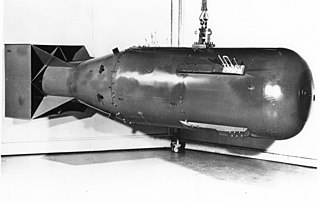
Little Boy was the name of the type of atomic bomb used in the bombing of the Japanese city of Hiroshima on 6 August 1945 during World War II, making it the first nuclear weapon used in warfare. The bomb was dropped by the Boeing B-29 Superfortress Enola Gay piloted by Colonel Paul W. Tibbets Jr., commander of the 509th Composite Group, and Captain Robert A. Lewis. It exploded with an energy of approximately 15 kilotons of TNT (63 TJ) and had an explosion radius of approximately 1.3 kilometers which caused widespread death across the city. The Hiroshima bombing was the second nuclear explosion in history, after the Trinity nuclear test.

A nuclear weapon is an explosive device that derives its destructive force from nuclear reactions, either fission or a combination of fission and fusion reactions, producing a nuclear explosion. Both bomb types release large quantities of energy from relatively small amounts of matter.
A neutron bomb, officially defined as a type of enhanced radiation weapon (ERW), is a low-yield thermonuclear weapon designed to maximize lethal neutron radiation in the immediate vicinity of the blast while minimizing the physical power of the blast itself. The neutron release generated by a nuclear fusion reaction is intentionally allowed to escape the weapon, rather than being absorbed by its other components. The neutron burst, which is used as the primary destructive action of the warhead, is able to penetrate enemy armor more effectively than a conventional warhead, thus making it more lethal as a tactical weapon.

Nuclear weapon designs are physical, chemical, and engineering arrangements that cause the physics package of a nuclear weapon to detonate. There are three existing basic design types:
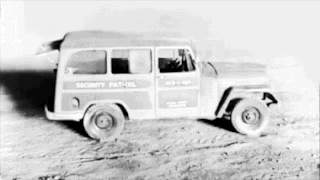
The effects of a nuclear explosion on its immediate vicinity are typically much more destructive and multifaceted than those caused by conventional explosives. In most cases, the energy released from a nuclear weapon detonated within the lower atmosphere can be approximately divided into four basic categories:

Project Plowshare was the overall United States program for the development of techniques to use nuclear explosives for peaceful construction purposes. The program was organized in June 1957 as part of the worldwide Atoms for Peace efforts. As part of the program, 35 nuclear warheads were detonated in 27 separate tests. A similar program was carried out in the Soviet Union under the name Nuclear Explosions for the National Economy.

Project Orion was a study conducted in the 1950s and 1960s by the United States Air Force, DARPA, and NASA into the viability of a nuclear pulse spaceship that would be directly propelled by a series of atomic explosions behind the craft. Early versions of the vehicle were proposed to take off from the ground; later versions were presented for use only in space. The design effort took place at General Atomics in San Diego, and supporters included Wernher von Braun, who issued a white paper advocating the idea. Non-nuclear tests were conducted with models, but the project was eventually abandoned for several reasons, including the 1963 Partial Test Ban Treaty, which banned nuclear explosions in space, amid concerns over nuclear fallout.

Nuclear weapons tests are experiments carried out to determine the performance, yield, and effects of nuclear weapons and have resulted until 2020 in up to 2.4 million people dying from its global fallout. Testing nuclear weapons offers practical information about how the weapons function, how detonations are affected by different conditions, and how personnel, structures, and equipment are affected when subjected to nuclear explosions. However, nuclear testing has often been used as an indicator of scientific and military strength. Many tests have been overtly political in their intention; most nuclear weapons states publicly declared their nuclear status through a nuclear test.
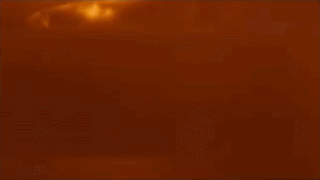
Operation Castle was a United States series of high-yield (high-energy) nuclear tests by Joint Task Force 7 (JTF-7) at Bikini Atoll beginning in March 1954. It followed Operation Upshot–Knothole and preceded Operation Teapot.
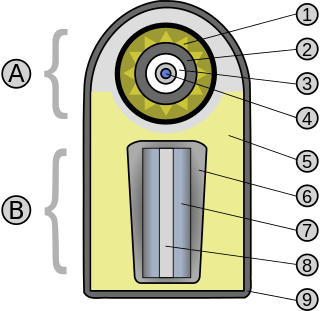
A thermonuclear weapon, fusion weapon or hydrogen bomb (H bomb) is a second-generation nuclear weapon design. Its greater sophistication affords it vastly greater destructive power than first-generation nuclear bombs, a more compact size, a lower mass, or a combination of these benefits. Characteristics of nuclear fusion reactions make possible the use of non-fissile depleted uranium as the weapon's main fuel, thus allowing more efficient use of scarce fissile material such as uranium-235 or plutonium-239. The first full-scale thermonuclear test was carried out by the United States in 1952 and the concept has since been employed by most of the world's nuclear powers in the design of their weapons.
Peaceful nuclear explosions (PNEs) are nuclear explosions conducted for non-military purposes. Proposed uses include excavation for the building of canals and harbours, electrical generation, the use of nuclear explosions to drive spacecraft, and as a form of wide-area fracking. PNEs were an area of some research from the late 1950s into the 1980s, primarily in the United States and Soviet Union.
A pure fusion weapon is a hypothetical hydrogen bomb design that does not need a fission "primary" explosive to ignite the fusion of deuterium and tritium, two heavy isotopes of hydrogen used in fission-fusion thermonuclear weapons. Such a weapon would require no fissile material and would therefore be much easier to develop in secret than existing weapons. Separating weapons-grade uranium (U-235) or breeding plutonium (Pu-239) requires a substantial and difficult-to-conceal industrial investment, and blocking the sale and transfer of the needed machinery has been the primary mechanism to control nuclear proliferation to date.

The explosive yield of a nuclear weapon is the amount of energy released such as blast, thermal, and nuclear radiation, when that particular nuclear weapon is detonated, usually expressed as a TNT equivalent (the standardized equivalent mass of trinitrotoluene which, if detonated, would produce the same energy discharge), either in kilotonnes (kt—thousands of tonnes of TNT), in megatonnes (Mt—millions of tonnes of TNT), or sometimes in terajoules (TJ). An explosive yield of one terajoule is equal to 0.239 kilotonnes of TNT. Because the accuracy of any measurement of the energy released by TNT has always been problematic, the conventional definition is that one kilotonne of TNT is held simply to be equivalent to 1012 calories.
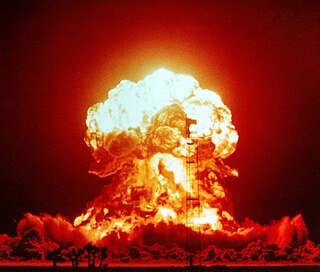
A nuclear explosion is an explosion that occurs as a result of the rapid release of energy from a high-speed nuclear reaction. The driving reaction may be nuclear fission or nuclear fusion or a multi-stage cascading combination of the two, though to date all fusion-based weapons have used a fission device to initiate fusion, and a pure fusion weapon remains a hypothetical device. Nuclear explosions are used in nuclear weapons and nuclear testing.

The W84 is an American thermonuclear warhead initially designed for use on the BGM-109G Gryphon Ground Launched Cruise Missile (GLCM).
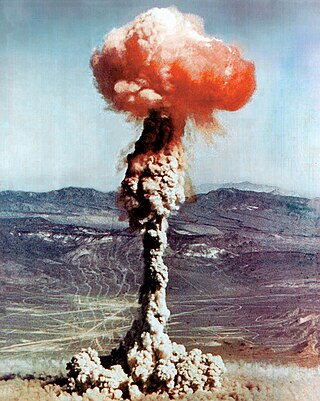
TNT equivalent is a convention for expressing energy, typically used to describe the energy released in an explosion. The ton of TNT is a unit of energy defined by convention to be 4.184 gigajoules, which is the approximate energy released in the detonation of a metric ton of TNT. In other words, for each gram of TNT exploded, 4.184 kilojoules of energy are released.

Aviation Thermobaric Bomb of Increased Power (ATBIP), nicknamed "Father of All Bombs", is a Russian-designed, bomber-delivered thermobaric weapon.

Operation Sailor Hat was a series of explosives effects tests, conducted by the United States Navy Bureau of Ships under the sponsorship of the Defense Atomic Support Agency. The tests consisted of two underwater explosions at San Clemente Island, California in 1964 and three surface explosions at Kahoʻolawe, Hawaii in 1965. They were non-nuclear tests employing large quantities of conventional explosives to determine the effects of a nuclear weapon blast on naval vessels, and the first major test of this kind since Operation Crossroads in July 1946.

Misty Picture was a test conducted on May 14, 1987 by the United States Defense Nuclear Agency involving the detonation of several thousand tons of conventional explosives to simulate the explosion of a small nuclear bomb.